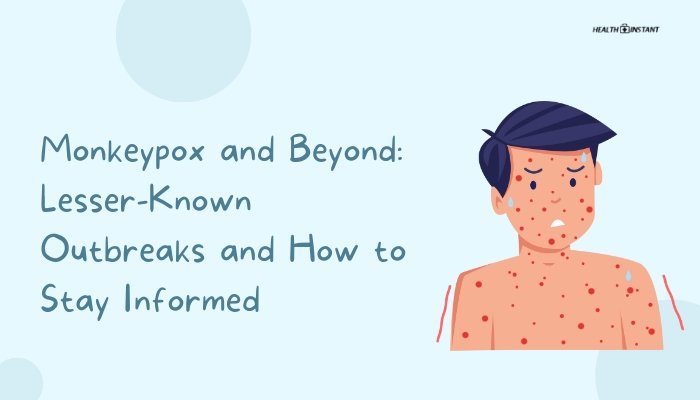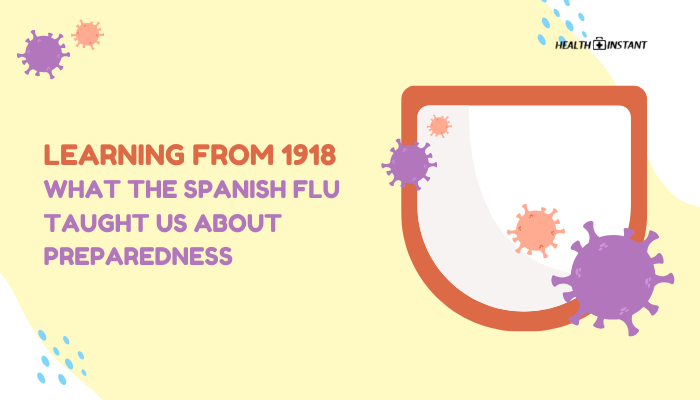Introduction
Global health emergencies often spotlight high-profile threats such as COVID-19 or influenza. Yet, many lesser-known outbreaks regularly surface worldwide. Diseases like monkeypox, Marburg virus, Lassa fever, or others might not garner the same headlines, but they pose real risks to communities.
Rapid travel, environmental changes, and global trade can accelerate the spread of once-regional pathogens, making awareness and readiness essential.
This article sheds light on monkeypox as a case study of an under-known disease that gained notoriety in recent years. It also explores other emerging viruses, how they spread, and the basic prevention steps that can minimize exposure.
Crucially, we cover reliable sources of health information so that individuals, travelers, and entire communities can stay informed. Learning from lesser-known outbreaks helps society remain vigilant, supports robust public health systems, and ultimately protects global well-being.
Why Focus on Lesser-Known Outbreaks?
Pandemics like COVID-19 underscore how quickly a new pathogen can alter daily life. Meanwhile, smaller-scale outbreaks occur regularly, often going unnoticed by the general public. Diseases with obscure names sometimes remain confined to certain areas—or they can unexpectedly jump regions, especially if vectors like mosquitoes, rodents, or international travelers carry them.
Learning about lesser-known outbreaks:
- Prepares communities: Timely knowledge can trigger improved surveillance, early diagnosis, and swift containment.
- Encourages research: Understanding rare diseases prompts targeted studies, vaccine development, and better diagnostic tools.
- Informs public behavior: Awareness fosters prudent precautions (e.g., avoiding animal contact in certain habitats, wearing protective clothing, or receiving relevant vaccines).
In a globalized world, no infectious disease is truly isolated. By expanding focus beyond mainstream threats, society builds resilience and stands ready to combat emerging infections effectively.
Monkeypox: A Quick Overview
Although first identified in monkeys, monkeypox primarily circulates in rodents. Sporadic outbreaks in humans often occurred in Central and West Africa. However, monkeypox saw increased detection outside these regions in recent years. This heightened attention underscores the disease’s potential to spread internationally and affect new populations.
Origins and Transmission
Monkeypox is caused by the monkeypox virus, a member of the Orthopoxvirus genus (the same family as the smallpox virus). Transmission can happen through:
- Animal-to-Human Contact: Handling infected rodents, squirrels, or primates. Bites, scratches, and direct contact with animal body fluids or lesions pose risks.
- Human-to-Human Contact: Direct skin-to-skin contact with lesions or respiratory droplets (for instance, prolonged face-to-face interaction).
- Contaminated Objects: Bedding, clothing, or other items that have come into contact with fluid or scabs from an infected person.
Symptoms and Complications
Monkeypox symptoms generally include:
- Fever and Chills
- Headaches and Muscle Aches
- Swollen Lymph Nodes
- A Rash or Pox-Like Lesions that often progress through stages: macules, papules, vesicles, pustules, and finally scabs.
While many recover within 2-4 weeks, complications such as secondary infections or pneumonia can arise, especially in immunocompromised individuals. Historical fatality rates of certain monkeypox strains in Africa have ranged between 1%-10%, though recent outbreaks in countries with robust healthcare may see lower rates.
Prevention and Treatment
Preventive measures revolve around limiting direct contact with infected individuals or animals:
- Avoid Animal Reservoirs: Refrain from touching wildlife in outbreak areas or using protective gear if necessary.
- Practice Hygiene: Regular handwashing, disinfecting surfaces, and mindful handling of bedding or laundry.
- Vaccination: Traditional smallpox vaccines or newer monkeypox-specific vaccines can offer protection.
- Supportive Care: Infections often resolve with rest, fluids, and treatment for secondary infections. Antivirals (like tecovirimat) may be available under certain guidelines.
Public health systems that quickly detect cases and isolate affected individuals can break transmission. Timely contact tracing and vaccination campaigns, if recommended, curb further spread.
Other Emerging Diseases to Watch
Lassa Fever
Originating from West Africa, Lassa fever is transmitted via rodents, notably the multimammate rat. Human infections occur if someone inhales or ingests particles contaminated by rat urine or feces. Symptoms range from mild malaise to hemorrhagic presentations. Early diagnosis and antiviral therapy (e.g., ribavirin) can be life-saving.
Marburg Virus Disease
A relative of Ebola, Marburg virus causes severe hemorrhagic fever with high fatality rates. Typically found in African fruit bats, it can jump to humans through direct exposure to bat caves or contact with infected individuals. Outbreak control hinges on isolating cases, wearing protective equipment, and burying victims safely.
Crimean-Congo Hemorrhagic Fever
Ticks spread this virus to livestock and people. Healthcare workers sometimes contract it from patient fluids. Initial flu-like symptoms can progress to hemorrhages, requiring supportive care and strict infection control. Prompt use of protective clothing in rural areas or medical settings significantly reduces risks.
Nipah Virus
Identified in Malaysia in 1998, Nipah is a paramyxovirus that fruit bats typically host. People often encounter it through contaminated date palm sap or contact with infected pigs. Encephalitis, seizures, and respiratory distress can occur in infected humans. Because of its ability to pass from person to person, close monitoring is essential once an outbreak is recognized.
Common Transmission Patterns
Despite their differences, many emerging infections share certain patterns:
- Animal Hosts (Zoonosis)
- Rodents, bats, and primates commonly harbor viruses that jump to humans.
- Animal-based products or bushmeat handling can trigger exposure.
- Rodents, bats, and primates commonly harbor viruses that jump to humans.
- Vector Bites or Contact
- Mosquitoes, ticks, or fleas spread diseases like dengue, Crimean-Congo hemorrhagic fever, or plague.
- Protective clothing, repellents, and environment control reduce bites.
- Mosquitoes, ticks, or fleas spread diseases like dengue, Crimean-Congo hemorrhagic fever, or plague.
- Human-to-Human
- Respiratory droplets, bodily fluids, or skin contact can pass viruses such as monkeypox, Nipah, or Marburg.
- Basic measures (isolating sick individuals, using protective equipment) contain these illnesses.
- Respiratory droplets, bodily fluids, or skin contact can pass viruses such as monkeypox, Nipah, or Marburg.
- Environmental Factors
- Rapid urbanization, deforestation, climate shifts, and wildlife trading heighten contact between humans and virus reservoirs.
- Rapid urbanization, deforestation, climate shifts, and wildlife trading heighten contact between humans and virus reservoirs.
Grasping these patterns helps travelers, healthcare providers, and local communities take preventive steps—such as avoiding unfamiliar animals, using insect repellents, or wearing masks in outbreak areas.
Staying Informed: Reliable Sources
Misinformation can confuse the public about outbreak severity or best practices. Turning to trustworthy, science-based platforms is crucial for accurate guidance.
Health Organizations and Agencies
- World Health Organization (WHO): Provides fact sheets, situation reports, and global alerts.
- Centers for Disease Control and Prevention (CDC): U.S. agency with clear guidelines, travel advisories, and disease updates.
- European Centre for Disease Prevention and Control (ECDC): Offers risk assessments and tailored advice for European countries.
Local and Regional Public Health Departments
Following official announcements or websites from your national or provincial ministries of health ensures relevant rules. Examples include quarantine directives, vaccine availability, or local outbreak data.
Trusted News and Scientific Outlets
Renowned news agencies often have health correspondents or medical experts covering new outbreaks. Peer-reviewed journals like The Lancet or the New England Journal of Medicine present advanced research, though the content can be technical. Summaries or commentaries by recognized specialists can bridge the gap.
Travel Advisories and Alerts
- Government Travel Websites: Many countries update advisories for travelers regarding areas with ongoing disease transmission.
- Airline Communications: Major carriers sometimes warn passengers, highlight in-flight precautions, or direct them to testing requirements.
By gathering information from multiple reputable channels, individuals avoid rumor-driven panic. Social media must be used wisely, verifying claims before sharing or acting on them.
Personal and Community Preparedness
Hygiene and Behavioral Practices
- Handwashing: Proper, frequent cleaning with soap or sanitizer drastically cuts infection risks.
- Protective Gear: Gloves, masks, or eye protection might be advised if dealing with potentially infected persons or animals.
- Distance: Minimizing close contact with symptomatic individuals, especially in outbreak zones.
Vaccinations and Preventive Measures
- Routine Immunizations: Some existing vaccines can offer partial or full protection (e.g., smallpox vaccine for monkeypox, yellow fever shot for certain countries).
- Post-Exposure Prophylaxis: If exposed, certain viruses have recommended treatments or antibody therapies within a tight window.
Workplace and Public Settings
- Policies for Sick Leave: Encouraging employees to stay home if unwell prevents local clusters.
- Disinfection Protocols: Regular cleaning of high-touch surfaces or shared spaces.
- Travel Guidelines: Screening, mandatory quarantine, or vaccine checks for staff traveling to high-risk areas.
Local readiness helps communities handle minor or moderate outbreaks with minimal upheaval. Also, established protocols bolster resilience when a more significant threat emerges.
Lessons from Past and Ongoing Outbreaks
From Ebola in West Africa to Zika in Latin America, patterns repeat:
- Early Detection: Quick identification and contact tracing can keep pathogens from spiraling.
- Community Engagement: Education fosters acceptance of measures like safe burials, quarantines, or vaccination campaigns.
- Global Cooperation: Sharing data, resources, and expertise across borders speeds containment.
- Preparedness: Stockpiling protective equipment, training healthcare workers, and building lab capacity shortens response times.
Monkeypox’s growth in non-endemic countries exemplifies how ignoring smaller diseases can lead to bigger problems later. Evolving systems ensure no outbreak is sidelined.
Conclusion
While mainstream media often highlights only the most catastrophic diseases, numerous lesser-known infections deserve attention. Pathogens like monkeypox, Lassa fever, Marburg, and Nipah underscore the varied ways viruses emerge, spread, and threaten public health.
Being informed offers a first line of defense: knowledge helps you adopt proper precautions, recognize symptoms early, and seek appropriate care.
Communities that remain updated via official channels—like the WHO, CDC, or local public health agencies—can confidently respond to new clusters. Basic strategies like hygiene, responsible travel, and immunization continue to reduce transmission.
At the organizational level, robust policies and flexible procedures help workplaces and social hubs adapt swiftly in an emergency.
By respecting these “under the radar” diseases, we strengthen our overall capacity to preserve health. Balanced awareness keeps panic at bay while ensuring rational, science-based decisions. In the end, preventing or mitigating an outbreak—large or small—protects families, economies, and the global community.
References
- World Health Organization. Monkeypox. Geneva: WHO; 2022.
- Centers for Disease Control and Prevention. About Monkeypox. Atlanta (GA): CDC; 2022.
- European Centre for Disease Prevention and Control. Risk assessment on monkeypox transmission. ECDC; 2022.
- Kortepeter MG, Jamil MS, Menachery V, Johnson RF. Infectious diseases with zoonotic potential. Lancet Infect Dis. 2021;21(10):e281-e286.
- Gonzalez JP, Saluzzo JF, LeGuenno B, Guillaud M. African haemorrhagic fevers and arbovirus infections. Infect Dis Clin N Am. 2020;11(2):297-315.
- Feldmann H, Jones S, Klenk HD, Schnittler HJ. Ebola virus: from discovery to vaccine. Nat Rev Immunol. 2003;3(8):677-685.
- Van Kerkhove MD. Brief literature review for the WHO global influenza research agenda—highly pathogenic avian influenza H5N1 risk in humans. Influenza Other Respir Viruses. 2020;5 Suppl 1:26-33.
- CDC Travelers’ Health. Travel advisories. Atlanta (GA): CDC; 2022.
- UK Health Security Agency. Guidance on monkeypox. London: UKHSA; 2022.
- Ariz JJ, Badio E, Mensah F. Transmission dynamics of Lassa fever in West Africa. Int J Infect Dis. 2021;10(3):157-161.
Disclaimer: The content herein is for informational purposes only and should not substitute professional medical advice, diagnosis, or treatment. Always consult qualified healthcare providers or public health agencies for guidance specific to your location or health situation.




